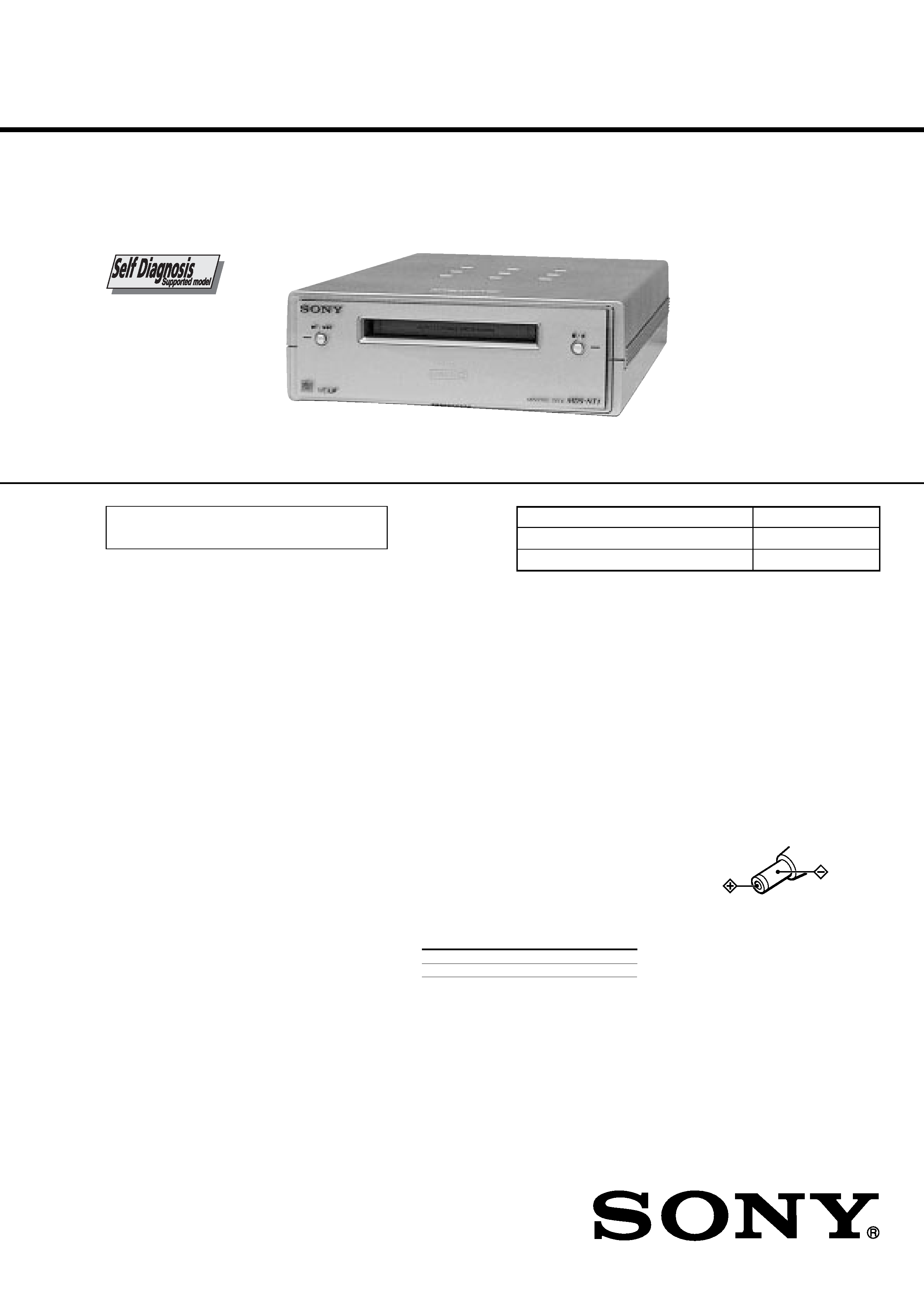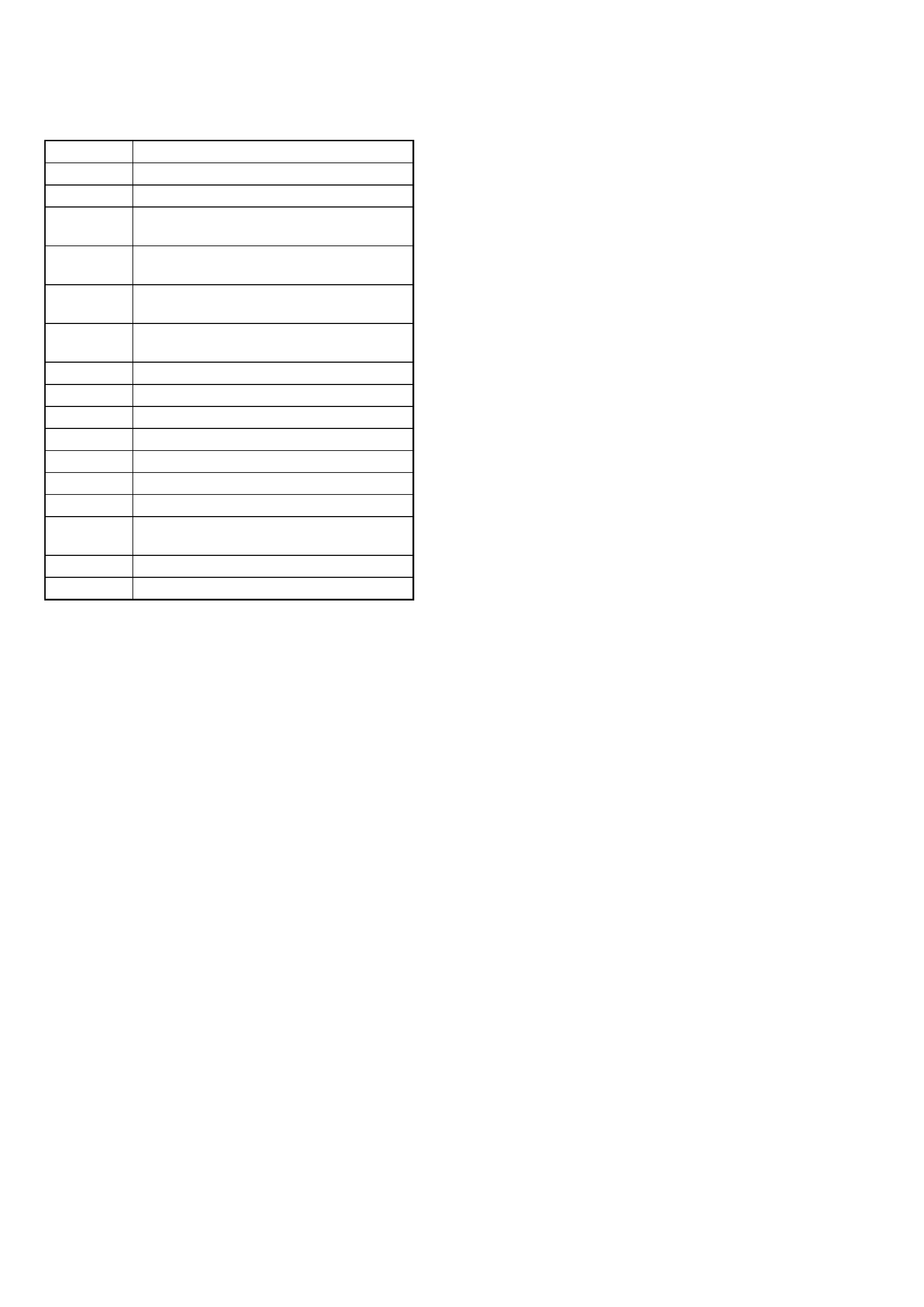
SERVICE MANUAL
MINIDISC DECK
AEP Model
UK Model
E Model
SPECIFICATIONS
MDS-NT1
US and foreign patents licensed from Dolby
Laboratories Licensing Corporation.
· Do not connect the supplied AC power adaptor to a
switched AC outlet (e.g., on an amplifier).
· Use only the supplied AC power adaptor. Do not
use any other AC power adaptor.
Polarity of the plug
System
MiniDisc digital audio system
Disc
MiniDisc
Laser
Semiconductor laser (
= 780 nm)
Emission duration: continuous
Revolutions (CLV)
800 rpm to 1800 rpm
Error correction
Advanced Cross Interleave Reed
Solomon Code (ACIRC)
Sampling frequency
44.1 kHz
Coding
Adaptive Transform Acoustic
Coding (ATRAC)/ATRAC 3
Modulation system
EFM (Eight-to-Fourteen
Modulation)
Number of channels
2 stereo channels
Frequency response
5 to 20,000 Hz
±0.8 dB
Signal-to-noise ratio
Over 96 dB during playback
Wow and flutter
Below measurable limit
Outputs
LINE (ANALOG) OUT
Jack type: stereo-mini
Rated output: 1 Vrms (at
50 kilohms)
Load impedance: Over 10 kilohms
PHONES
Jack type: stereo-mini
Rated output: 5 mW
Load impedance: 32 ohms
General
USB port
series B, self powerd, full speed
Where purchased
Power requirements*
Europe and other countries 220 230 V AC, 50/60 Hz
* Using an AC power adaptor (supplied)
Power consumption
6 W
Dimensions (approx.)
152
× 52 × 249 mm (w/h/d) incl.
projecting parts and controls
Mass (approx.)
1.0 kg
Supplied accessories
Design and specifications are subject to change
without notice.
· AC power adaptor (1)
· USB cable (1)
· Audio connecting cord
(stereo mini-plug
×1 y stereo mini-plug ×1)
(1)
· OpenMG Jukebox CD-ROM (1)
· Operating instructions for OpenMG Jukebox
(1)
Ver 1.0 2002.02
9-873-614-01
Sony Corporation
2002B0500-1
Home Audio Company
C
2002.02
Published by Sony Engineering Corporation
Model Name Using Similar Mechanism
NEW
MD Mechanism Type
MDM-7S2B
Optical Pick-up Name
KMS-262E
· OpenMG, "MagicGate", "MagicGate Memory
Stick", "Memory Stick", VAIO, MusicClip, Net MD,
and their logos are trademarks of Sony Corporation.
·"WALKMAN " is a trademark of Sony Corporation.
· Microsoft, Windows, Windows NT and Windows Me-
dia are trademarks or registered trademarks of
Microsoft Corporation in the United States and/or
other countries.
· IBM and PC/AT are registered trademarks of Interna-
tional Business Machines Corporation.
· Macintosh is a trademark of Apple Computer,Inc.in
the United States and/or other countries.
· MMX and Pentium are trademarks or registered trade-
marks of Intel Corporation.
· All other trademarks are trademarks of their respec-
tive owners.TM and ® marks are omitted in this manual.

2
MDS-NT1
SELF-DIAGNOSIS FUNCTION
The self-diagnosis function consists of error codes for customers which are displayed automatically when errors occur, and error codes
which show the error history in the test mode during servicing. For details on how to view error codes for the customer, refer to the
following box in the instruction manual. For details on how to check error codes during servicing, refer to the following "Procedure for
using the Self-Diagnosis Function (Error History Display Mode)".
PROCEDURE FOR USING THE SELF-DIAGNOSIS FUNCTION (ERROR HISTORY DISPLAY MODE)
The deck's self-diagnosis function automatically checks the condition of the MD deck when an error
occurs, then indicates the nature of the error through the two indicators. If the indicators light up or flash,
find them in the following table and perform the indicated countermeasure. Should the problem persist,
consult your nearest Sony dealer.
Playback
Indicator
(green)
Recording
Indicator
(red)
Cause/Remedy
Flashes
The recording was not made properly. (C13/Rec Error)
, Set the deck in a stable surface, and repeat the recording procedure.
Flashes
The inserted MD is dirty (with smudges, fingerprints, etc.), scratched, or
substandard in quality. (C13/Rec Error)
, Replace the disc and repeat the recording procedure.
Flashes
The deck could not read the TOC on the MD properly. (C13/Read Error)
, Take out the MD and insert it again.
Lights up
The deck could not read the TOC on the MD properly. (C14/Toc Error)
, Insert another disc.
, If possible, erase all the tracks on the MD.
Lights up
Lights up
There is an error in the internal data that the deck needs in order to operate.
(E0001/MEMORY NG)
, Consult your nearest Sony dealer.
Flashes
Flashes
There is a problem with the optical pickup. (E0101/LASER NG)
, Consult your nearest Sony dealer.
Both indicators flash alternately
An MD loading problem has occurred. (E0201/LOADING NG)
, Consult your nearest Sony dealer.
B/>
x/Z
Note 1:The test mode and recording of this set are controlled by a personal computer, thus requiring the set to be connected to the PC.
Prepare the personal computer in which necessary software is already installed.
· Attached software "OpenMG Jukebox" (necessary for recording (check in, check out)) (Part No. : 4-237-880-01)
· Software for test mode "TestMode_S.exe" ("TestMode_S.exe" and essential files "data_files.csv", "Net MDUSB.dil" are distributed to-
gether with the Service Manual. For the test mode, copy these three files in the same folder beforehand)
Note 2:In the operation in the test mode, the operational description requiring "click [xxx]" means that you have to click the button on the screen.
("xxx" indicates the button name)
Note 3:Perform the self-diagnosis function in the "error history display mode" in the test mode. The following describes the least required procedure.
Be careful not to enter other modes by mistake. If you set other modes accidentally, click the [MENU/NO] to exit the mode.
1. Press the [
] button and [
] button until the NetMD indicator turns off (for more than 3 seconds). (During this step, the USB
cable must be disconnected)
2. Connect the set to the PC with the attached USB cable.
3. Start up the software for test mode.
4. Click the [TEST MODE].
5. Click the [JOG UP] or [JOG DOWN] and when "[Service]" is displayed, click the [ENTER/YES].
6. Click the [JOG UP] or [JOG DOWN] to display "Err Display".
7. Click the [ENTER/YES] to sets the error history mode and displays "op rec tm".
8. Select the contents to be displayed or executed using the [JOG UP] or [JOG DOWN].
9. Click the [PUSH] to display or execute the contents selected.
10. Click the [PUSH] another time returns to step 8.
11. Click the [MENU/NO] to display "Err Display" and release the error history mode.
12. To release the test mode, quit the software for test mode after the [REPEAT] clicked.
Note: When retrying this operation, start from step1.

3
MDS-NT1
ITEMS OF ERROR HISTORY MODE ITEMS AND CONTENTS
Selecting the Test Mode
Display
Details of History
op rec tm
Cumulative recording time is displayed.
When cumulative recording time is over 1 minute, the hour and minute are displayed as they are.
When it is under 1 minute, "Under 1 min" is displayed.
The displayed time shows how long the laser is in high power state.
It is about one fourth the actual recording time.
op play tm
Cumulative playing time is displayed.
When cumulative playing time is over 1 minute, the hour and minute are displayed as they are.
When it is under 1 minute, "Under 1 min" is displayed.
spdl rp tm
Cumulative spindle motor running time is displayed.
When cumulative spindle motor run time is over 1 minute, the hour and minute are displayed as they are.
When it is under 1 minute, "Under 1 min" is displayed.
retry err
Displays the total number of retries during recording and number of retry errors during play.
Displayed as "rss pss".
"r" indicates the retries during recording while "p" indicates the retry errors during play.
The number of retries and retry errors are displayed in hexadecimal digits from 00 to FF.
total err
Displays the total number of errors.
Displayed as "total ss".
The number of errors is displayed in hexadecimal digits from 00 to FF.
err history
Displays the 10 latest errors.
Displayed as "0s ErrCd@@".
s indicates the history number. The smaller the number, the more recent is the error. (00 is the latest).
@@ indicates the error code.
Refer to the following table for the details. The error history can be switched by clicking the [JOG UP] or
[JOG DOWN].
retry adrs
Displays the past five retry addresses.
Displays "ss ADRS ssss", ss is the history number, ssss is the cluster with the retry error.
Select the error history number using the [JOG UP] or [JOG DOWN].
er refresh
Mode to clear the error history and retry address history.
[Operating method]
1) Click the [JOG UP] or [JOG DOWN] when "er refresh" is displayed.
2) The display will change to "er refresh?", and then click the [ENTER/YES].
The operation is over if "Complete!" is displayed.
After this mode was executed, check the following:
· The data have been cleared.
· Perform the recording and playing to check that the mechanism operates normally.
tm refresh
Mode to clear the "op rec tm" and "op play tm" histories.
These histories serve as approximate indications of when to replace the optical pick-up. If the optical pick-up
has been replaced, perform this operation and clear the history.
[Operating method]
1) Click the [JOG UP] or [JOG DOWN] when "tm refresh" is displayed.
2) The display will change to "tm refresh?", and then click the [ENTER/YES].
The operation is over if "Complete!" is displayed.
After this mode was executed, check the following:
· The data have been cleared.
· Perform the recording and playing to check that the mechanism operates normally.
op change
Mode to clear cumulative time of "op rec tm" and "op play tm".
These historical data are used to determine the timing when the optical pick-up is to be replaced. When the
optical pick-up was replaced, perform this operation to clear historical data.
[Operating method]
1) Click the [JOG UP] or [JOG DOWN] when "op change" is displayed.
2) The display will change to "op chang?", and then click the [ENTER/YES].
The operation is over if "Complete!" is displayed.
spdl change
Mode to clear cumulative time of "spdl rp tm".
This historical data is used to determine the timing when the spindle motor is to be replaced. When the spindle
motor was replaced, perform this operation to clear historical data.
[Operating method]
1) Click the [JOG UP] or [JOG DOWN] when "spdl change" is displayed.
2) The display will change to "spdl chang?", and then click the [ENTER/YES].
The operation is over if "Complete!" is displayed.

4
MDS-NT1
Error Code
Details of Error
10
Loading failed
12
Loading switch combination is illegal
20
Head of PTOC could not be read within the
specified time
21
Head of PTOC could be read but its content is
erroneous
22
Access to UTOC could not be made within the
specified time
23
UTOC could be not read within the specified
3time
24
Content of UTOC is erroneous
30
Playing could not start
31
Content of sector is erroneous
40
Cause of retry occurred during normal recording
41
D-RAM overflowed and retry was executed
42
Retry was executed during the writing to TOC
43
S.F editing was interrupted by retry
50
Address could not be read except in access
processing
51
Focusing failed and it is out of control
60
Unlock retry
Table of Error Codes

5
MDS-NT1
SELF-DIAGNOSIS FUNCTION ........................... 2
1.
SERVICING NOTES ............................................... 7
2.
GENERAL ................................................................... 12
3.
DISASSEMBLY
3-1. Disassembly Flow ........................................................... 13
3-2. Case (Upper) ................................................................... 14
3-3. Main Board ...................................................................... 15
3-4. MD Mechanism Deck (MDM-7S2B) ............................. 15
3-5. Front Panel Section ......................................................... 16
3-6. BD Board, Over Write Head (HR901) ........................... 16
3-7. Holder Assy ..................................................................... 17
3-8. Loading Motor Assy (M103) .......................................... 17
3-9. Sled Motor Assy (M102) ................................................ 18
3-10. Optical Pick-Up (KMS-262E) ........................................ 18
3-11. Spindle Motor Assy (M101) ........................................... 19
4.
TEST MODE .............................................................. 20
5.
ELECTRICAL ADJUSTMENTS ........................ 24
6.
DIAGRAMS
6-1. Block Diagram SERVO Section ............................... 36
6-2. Block Diagram MAIN Section ................................. 37
6-3. Note for Printed Wiring Boards and
Schematic Diagrams ....................................................... 38
6-4. Printed Wiring Board BD Board .............................. 39
6-5. Schematic Diagram BD Board (1/2) ........................ 40
6-6. Schematic Diagram BD Board (2/2) ........................ 41
6-7. Printed Wiring Board
MAIN Board (Component Side) .............................. 42
6-8. Printed Wiring Board
MAIN Board (Conductor Side) ................................ 43
6-9. Schematic Diagram MAIN Board (1/2) ................... 44
6-10. Schematic Diagram MAIN Board (2/2) ................... 45
6-11. Printed Wiring Board Panel Board ........................... 46
6-12. Schematic Diagram Panel Board .............................. 47
6-13. IC Pin Function Description ........................................... 51
7.
EXPLODED VIEWS
7-1. Case Section .................................................................... 59
7-2. Front Panel Section ......................................................... 60
7-3. Case (B) Section .............................................................. 61
7-4. MD Mechanism Deck Section-1 (MDX-7S2B) ............. 62
7-5. MD Mechanism Deck Section-2 (MDX-7S2B) ............. 63
8.
ELECTRICAL PARTS LIST ............................... 64
TABLE OF CONTENTS
